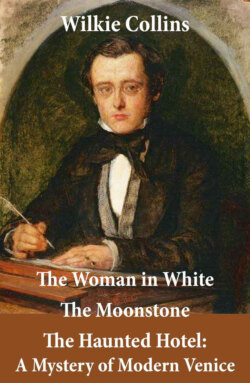Читать книгу The Woman in White (illustrated) + The Moonstone + The Haunted Hotel: A Mystery of Modern Venice - Уилки Коллинз - Страница 5
На сайте Литреса книга снята с продажи.
Preface
ОглавлениеTable of Contents
“The Woman in White” has been received with such marked favour by a very large circle of readers, that this volume scarcely stands in need of any prefatory introduction on my part. All that it is necessary for me to say may be summed up in a few words.
I have endeavoured, by careful correction and revision, to make my story as worthy as I could of a continuance of the public approval. Certain technical errors which had escaped me while I was writing the book are here rectified. None of these little blemishes in the slightest degree interfered with the interest of the narrative — but it was as well to remove them at the first opportunity, out of respect to my readers; and in this edition, accordingly, they exist no more.
Some doubts having been expressed, in certain captious quarters, about the correct presentation of the legal “points” incidental to the story, I may be permitted to mention that I spared no pains — in this instance, as in all others — to preserve myself from unintentionally misleading my readers. A solicitor of great experience in his profession most kindly and carefully guided my steps, whenever the course of the narrative led me into the labyrinth of the Law. Every doubtful question was submitted to this gentleman, before I ventured on putting pen to paper; and all the proof-sheets which referred to legal matters were corrected by his hand before the story was published. I can add, on high judicial authority, that these precautions were not taken in vain. The “law” in this book has been discussed, since its publication, by more than one competent tribunal, and has been decided to be sound.
One word more, before I conclude, in acknowledgment of the heavy debt of gratitude which I owe to the reading public. It is no affectation on my part to say that the success of this book has been especially welcome to me, because it implied the recognition of a literary principle which has guided me since I first addressed my readers in the character of a novelist.
I have always held the old-fashioned opinion that the primary object of a work of fiction should be to tell a story; and I have never believed that the novelist who properly performed this first condition of his art, was in danger, on that account, of neglecting the delineation of character — for this plain reason, that the effect produced by any narrative of events is essentially dependent, not on the events themselves, but on the human interest which is directly connected with them. It may be possible, in novel-writing, to present characters successfully without telling a story; but it is not possible to tell a story successfully without presenting characters; their existence, as recognisable realities, being the sole condition on which the story can be effectively told. The only narrative which can hope to lay a strong hold on the attention of readers, is a narrative which interests them about men and women — for the perfectly obvious reason that they are men and women themselves.
The reception accorded to “The Woman in White” has practically confirmed these opinions, and has satisfied me that I may trust to them in the future. Here is a novel which has met with a very kind reception, because it is a Story; and here is a story, the interest of which — as I know by the testimony, voluntarily addressed to me, of the readers themselves — is never disconnected from the interest of character. “Laura,” “Miss Halcombe,” and “Anne Catherick;” “Count Fosco,” “Mr. Fairlie,” and “Walter Hartright;” have made friends for me wherever they have made themselves known. I hope the time is not far distant when I may meet those friends again, and when I may try, through the medium of new characters, to awaken their interest in another story.
Harley Street, London
February 1861.
